
A semi-trailer truck, is the combination of a tractor unit and one or more semi-trailers to carry freight. A semi-trailer attaches to the tractor with a type of hitch called a fifth wheel.
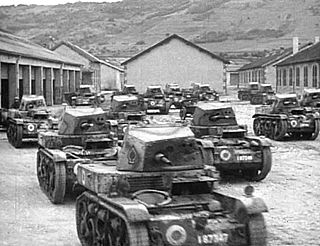
The Automitrailleuse de Reconnaissance Renault Modèle 35 Type ZT was a French light tank developed during the Interbellum and used in the Second World War. It was not intended to reconnoitre and report as its name suggests but was a light armoured combat vehicle, mostly without a radio and used as a support tank for the mechanised infantry.
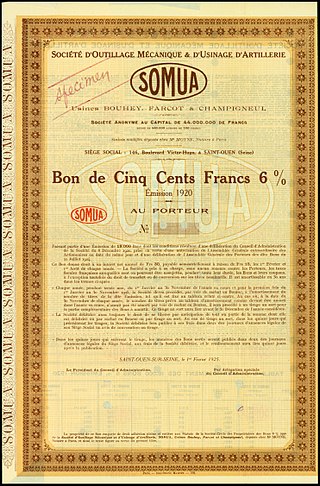
Somua, an acronym for Société d'outillage mécanique et d'usinage d'artillerie, was a French company that manufactured machinery and vehicles. A subsidiary of Schneider-Creusot, Somua was based in Saint-Ouen, a suburb of Paris.

The Renault UE Chenillette is a light tracked armoured carrier and prime mover produced by France between 1932 and 1940.

The Lorraine 37L or Tracteur de ravitaillement pour chars 1937 L, is a light tracked armoured vehicle developed by the Lorraine company during the interwar period or interbellum, before the Second World War, to an April 1936 French Army requirement for a fully armoured munition and fuel supply carrier to be used by tank units for front line resupply. A prototype was built in 1937 and production started in 1939. In this period, two armoured personnel carriers and a tank destroyer project were also based on its chassis. Mainly equipping the larger mechanised units of the French Infantry arm, the type was extensively employed during the Battle of France in 1940. After the defeat of France, clandestine manufacture was continued in Vichy France, culminating in a small AFV production after the liberation and bringing the total production to about 630 in 1945. Germany used captured vehicles in their original role of carrier and later, finding the suspension system to be particularly reliable, rebuilt many into tank destroyers of the Marder I type or into self-propelled artillery.

Sisu Auto is a truck manufacturer based in Raseborg, Finland. Its name comes from the Finnish word sisu meaning guts, grit and determination.

An articulated hauler, articulated dump truck (ADT), or sometimes a dump hauler, is a very large heavy-duty type of dump truck used to transport loads over rough terrain, and occasionally on public roads. The vehicle usually has all-wheel drive and consists of two basic units: the front section, generally called the tractor, and the rear section that contains the dump body, called the hauler or trailer section. Steering is made by pivoting the front in relation to the back by hydraulic rams. This way, all wheels follow the same path, making it an excellent off-road vehicle.
Automobiles Industriels Latil, commonly known as Latil, was a French manufacturer of commercial and military vehicles created to manage the assets of the defunct Compagnie Française d'Mecánique et d'Automobiles, to market Georges Latil's avant-train Latil, an early front-wheel drive system. The company was established in 1909 by entrepreneur Charles Blum as Charles Blum & Cie. It started to use Automobiles Industriels Latil in the 1910s as a trading name. The company started to produce military vehicles by the 1910s and commercial ones in great numbers by the end of World War I. In 1928, the company adopted its trading name as its legal name. It was dissolved in 1955 after being merged into the Saviem group.

The Club of Four was an alliance of four European truck manufacturers: Saviem, Volvo, DAF, and Magirus-Deutz.

Sisu Polar is a truck model series produced by the Finnish heavy vehicle producer Sisu Auto. It came into the market in 2011 and the main applications are earthmovers, logging trucks, road maintenance vehicles, mobile cranes and heavy machinery hauliers which are fully equipped in the factory. The series includes two main variants DK12M and DK16M. The number of axles is 3, 4 or 5. Mercedes-Benz supplies some key components; cabins and engines in particular.

The Renault R-series was a range of heavy-duty trucks built by Renault Véhicles Industrielles (RVI) from 1980 until 1996. The cabin was Berliet's KB 2400 model, originally introduced in 1977. The fusion of Saviem and Berliet into RVI brought with it a consolidation of the lineups, although the Saviem and Berliet badges continued to be used for some time. The KB 2400 cabin was also used by Ford Transcontinental. The R-series ranged from the smallest R280 to the V8-powered R420.
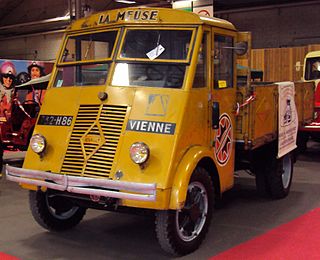
The Renault AHx was a range of light/medium trucks with carrying capacities from 2 to 5 tonnes manufactured by Renault between 1941 and 1947. Various versions were used in World War II by the German forces.

The Tracteur Panhard-Châtillon (French pronunciation:[tʁaktœʁpanaʁ ʃatijɔ̃] was a conventional-cabin, all-wheel drive truck produced between 1911 and 1918 by the French manufacturer Panhard. It was one of the first all-wheel drive trucks used by the French military.
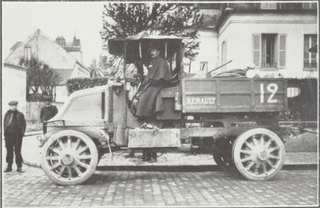
The Renault EG is an all-wheel drive truck/artillery tractor produced between 1914 and 1919 by the French manufacturer Renault.
The Renault AGx was a range of light/medium/heavy trucks produced by the French manufacturer Renault between 1937 and 1941. The range includes both conventional and forward control trucks.

The Renault ACx and ADx is a range of light/medium trucks produced by the French manufacturer Renault between 1935 and 1940. From the range derived some buses.

The Fiat 619 is a multi-purpose truck, tractor for Semi-trailer trucks, manufactured from 1964 to 1980 and part of the Fiat V.I. family of heavy vehicles. The truck was intended to replace the Fiat 682 in production since 1952, but the manufacturing of the latter continued until 1984, also thanks to the demands of the African market.

The early 1930s Renault commercial vehicles were a range of modular chassis produced by Renault, sold under various configurations, primarily trucks, buses and coaches. The range was the first from Renault to get diesel engines and it abandoned previous design styles from the company. The range was gradually replaced from 1935 onwards by the ACx and ADx light range, the ABx medium range and the ZP bus/coach.
The Latil H14 and H16 A1 is a range of medium-duty/heavy-duty trucks with a forward control design for road transport produced by French manufacturer Latil and later Saviem. The Latil H14 and H16 A1 were the last road trucks of Latil origin produced by Saviem. The range was heavily modularised, with standardised pieces and mostly using just a couple of engines throughout its run.
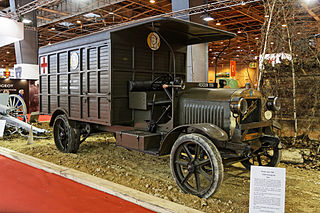
The Berliet CBA is a series of medium-duty trucks with chain drive, initially for the military and later also for commercial use. It was produced by the French manufacturer Berliet from 1913 to 1932, and was one of the most used trucks in World War I. It was replaced by the Berliet GD series.



















